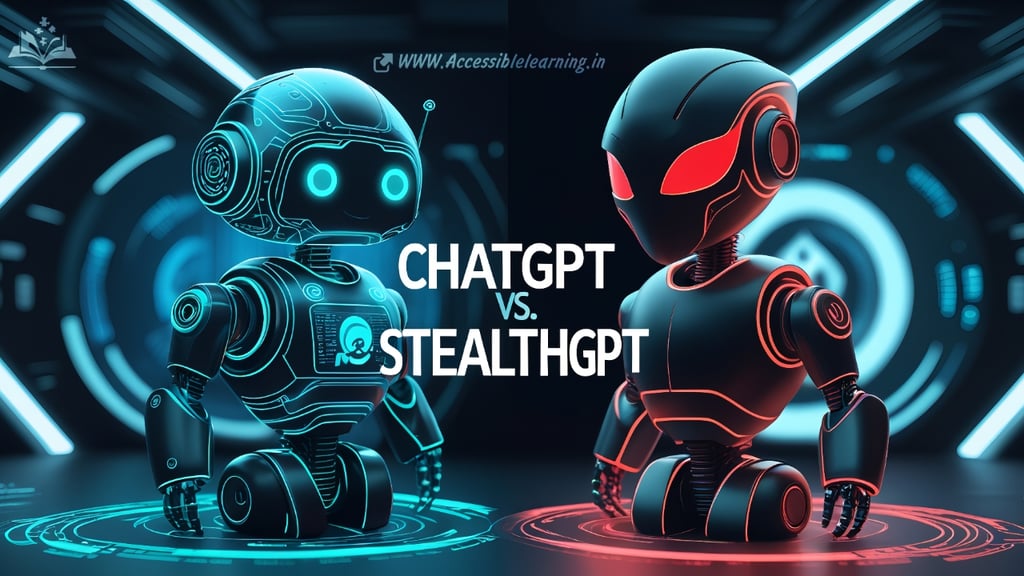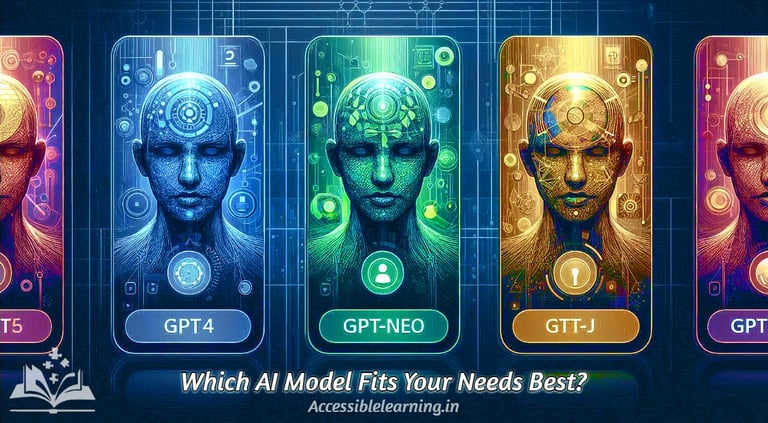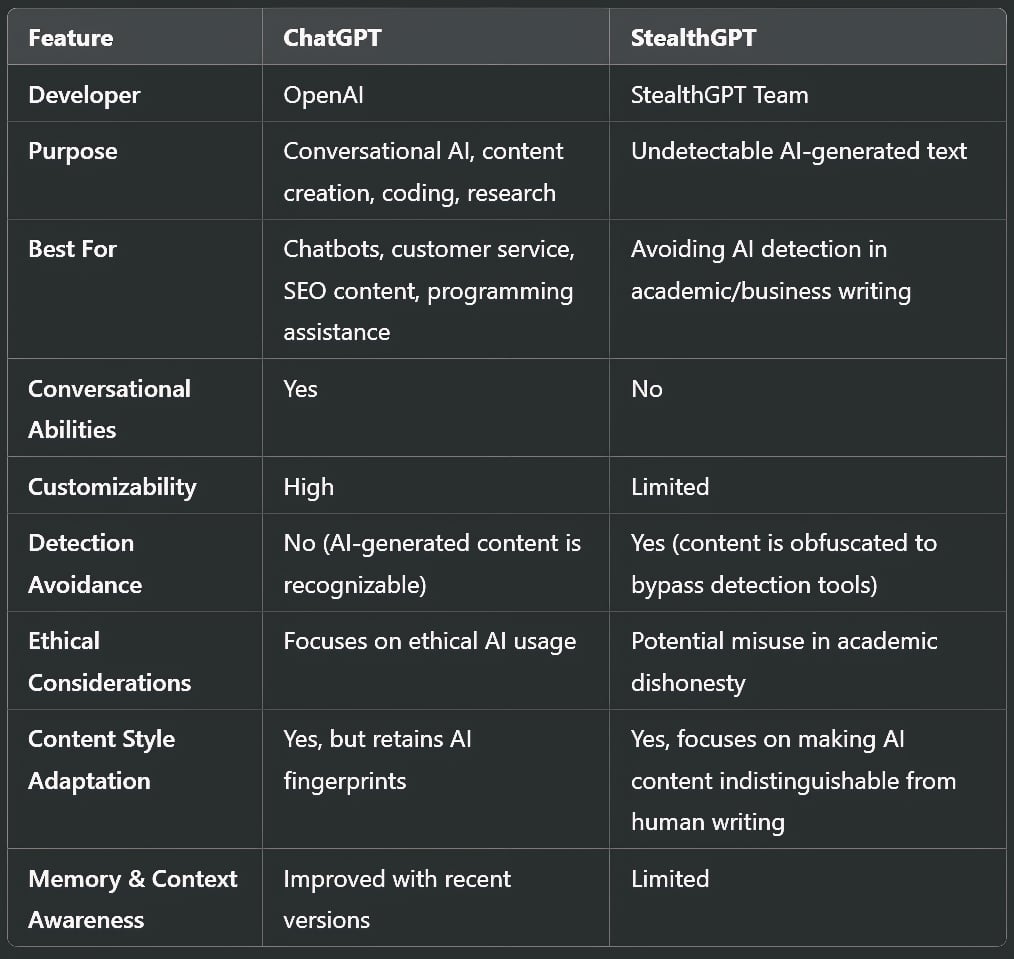
ChatGPT vs. StealthGPT: Which AI Model is Right for You?
ChatGPT vs. StealthGPT: A detailed comparison of these two AI models, exploring their features, differences, use cases, and ethical concerns. Learn which tool suits your needs best—whether for covert AI, content creation, or undetectable AI-generated text.
AI ASSISTANTAI/FUTURECOMPANY/INDUSTRYEDUCATION/KNOWLEDGEEDITOR/TOOLS
Sachin K Chaurasiya
2/25/20254 min read


Artificial intelligence has significantly evolved, making AI-powered chatbots and content-generation tools a valuable asset for individuals and businesses. Two notable AI models in this domain are ChatGPT and StealthGPT. While ChatGPT, developed by OpenAI, is widely recognized for its conversational abilities and versatile applications, StealthGPT is designed primarily for undetectable AI-generated text. This article delves into their functionalities, differences, use cases, and potential limitations to help users make an informed choice.
What is ChatGPT?
ChatGPT is an AI language model developed by OpenAI, designed for generating human-like text based on user prompts. It is widely used for various applications, including:
Conversational AI
Content creation
Programming assistance
Research and knowledge sharing
Customer support automation
Personal productivity (e.g., summarizing notes, drafting emails, and brainstorming ideas)
Language translation and tutoring
Key Features
Natural Language Processing (NLP): ChatGPT generates coherent and contextually appropriate responses.
Multifunctional: It can be used for writing, brainstorming, summarizing, and even coding.
Customizable: Users can fine-tune responses by providing context and instructions.
Integration Capabilities: It can be integrated into apps, websites, and various business tools.
Ethical AI Usage: ChatGPT is designed with ethical guidelines and moderation systems to prevent harmful content generation.
Advanced Context Handling: The newer versions have improved memory capabilities, making them better at maintaining long conversations.
Extensive Knowledge Base: Trained on vast datasets, enabling it to provide diverse and well-researched responses.
Technical
Model Type
Transformer-based AI model, powered by OpenAI’s GPT-4 architecture (latest version).
Training Data
Trained on a vast dataset of books, articles, websites, and human conversations.
Data includes programming, scientific knowledge, historical information, and more.
Core Features
Uses Reinforcement Learning from Human Feedback (RLHF) for improved accuracy.
Memory & Context Awareness: Maintains multi-turn conversations.
Multimodal Capabilities (GPT-4-turbo): Can process text, images, and some advanced reasoning.
Supports API integration for businesses and developers.
AI Detection
ChatGPT’s content is recognizable by AI-detection tools because it follows common patterns of AI-generated text.
Strengths
Advanced natural language processing (NLP)
Handles conversations effectively
Versatile for multiple use cases (content creation, coding, research, chatbots)
Ethical AI development with safety features
Integration into APIs, apps, and business tools
Memory and contextual awareness improvements
Weaknesses
AI-generated content can still be detected
May provide inaccurate or biased information
Struggles with very long-form contextual retention
Ethical constraints prevent certain content generation
AI hallucination issues (generating plausible but incorrect information)
Use Cases
Businesses & Marketing: Writing blogs, emails, and ad copy.
Customer Support: Automating responses for improved efficiency.
Programming Assistance: Debugging, generating code, and explaining concepts.
Education & Learning: Answering queries, tutoring, and brainstorming ideas.
Creative Writing: Generating stories, poetry, and brainstorming creative content.
SEO Optimization: Creating keyword-rich content for higher search rankings.
Research Assistance: Summarizing articles and providing references for academic or professional use.


What is StealthGPT?
StealthGPT is an AI-powered writing tool marketed as an "undetectable AI-generated text generator." Unlike ChatGPT, which is built for general-purpose AI interactions, StealthGPT is designed to bypass AI detection tools used to identify machine-generated content.
Key Features
AI Text Obfuscation: It modifies AI-generated text to make it appear more human-written.
Bypassing AI Detectors: Specifically built to help users create content that avoids detection by tools like Turnitin and GPT detectors.
Content Writing Focus: Primarily aimed at generating essays, articles, and reports with an emphasis on avoiding AI identification.
Less Conversational: Unlike ChatGPT, it is not optimized for chatbot applications but instead specializes in rewriting AI-generated text to be more human-like.
Customizable Writing Style: Allows users to specify tone, style, and complexity to ensure authenticity.
Continuous Adaptation: StealthGPT evolves its techniques as AI detection tools improve, maintaining effectiveness.
Technical
Model Type
Modified version of large language models (LLMs) with AI text obfuscation techniques.
Training Data
Likely trained on various text datasets but fine-tuned to evade AI detection.
Uses rewriting techniques to mimic human writing patterns.
Core Features
AI Stealth Technology: Alters sentence structures, vocabulary, and phrasing to bypass AI detection.
No Conversational Capabilities: Focused solely on text transformation.
Continuous Adaptation: Keeps updating its rewriting methods as AI detection tools evolve.
AI Detection Avoidance
Uses techniques such as synonym replacement, sentence restructuring, and text variation.
Unlike ChatGPT, it avoids detectable AI patterns by randomizing output structure.
Strengths
Bypasses AI detection tools effectively
Generates undetectable AI-written text
Customizable writing styles
Ideal for rewriting AI-generated content to appear human-like
Continuously adapts to evolving AI detectors
Weaknesses
Limited versatility (not useful for chatbots, coding, or research)
Ethical concerns related to plagiarism and academic dishonesty
Not designed for real-time interaction
Must constantly update to stay ahead of AI detectors
More prone to grammar or coherence errors compared to ChatGPT
Use Cases
Avoiding AI Detection: Writing essays or reports that need to pass AI content detectors.
Generating Plagiarism-Free Content: Avoiding text flagged as AI-generated.
Academic Writing (Ethical Concerns): While useful, it may encourage unethical practices in education.
Rewriting AI-Generated Text: Ensuring content appears more natural and human-like.
Job Applications & Cover Letters: Generating professional documents that appear authentically human-written.


Which One Should You Choose?
The choice between ChatGPT and StealthGPT depends on your needs.
Choose ChatGPT if you want a powerful AI model for conversations, content creation, business automation, and coding assistance.
Choose StealthGPT if your primary goal is to bypass AI detection and generate human-like text that is difficult to flag as AI-written.
For ethical and practical reasons, ChatGPT remains the superior option for long-term AI-powered interactions. While StealthGPT serves a niche function, it raises concerns about academic honesty and ethical AI use. Users should consider the implications of AI-generated content and ensure they use these tools responsibly.
Both ChatGPT and StealthGPT serve different purposes. ChatGPT excels as a general-purpose AI tool for content generation, coding, and conversation, while StealthGPT focuses on making AI-generated text undetectable. Choosing the right tool depends on your needs, but ethical considerations should always be a priority. As AI continues to evolve, responsible usage will determine the true impact of these technologies on various industries.
Subscribe To Our Newsletter
All © Copyright reserved by Accessible-Learning Hub
| Terms & Conditions
Knowledge is power. Learn with Us. 📚


